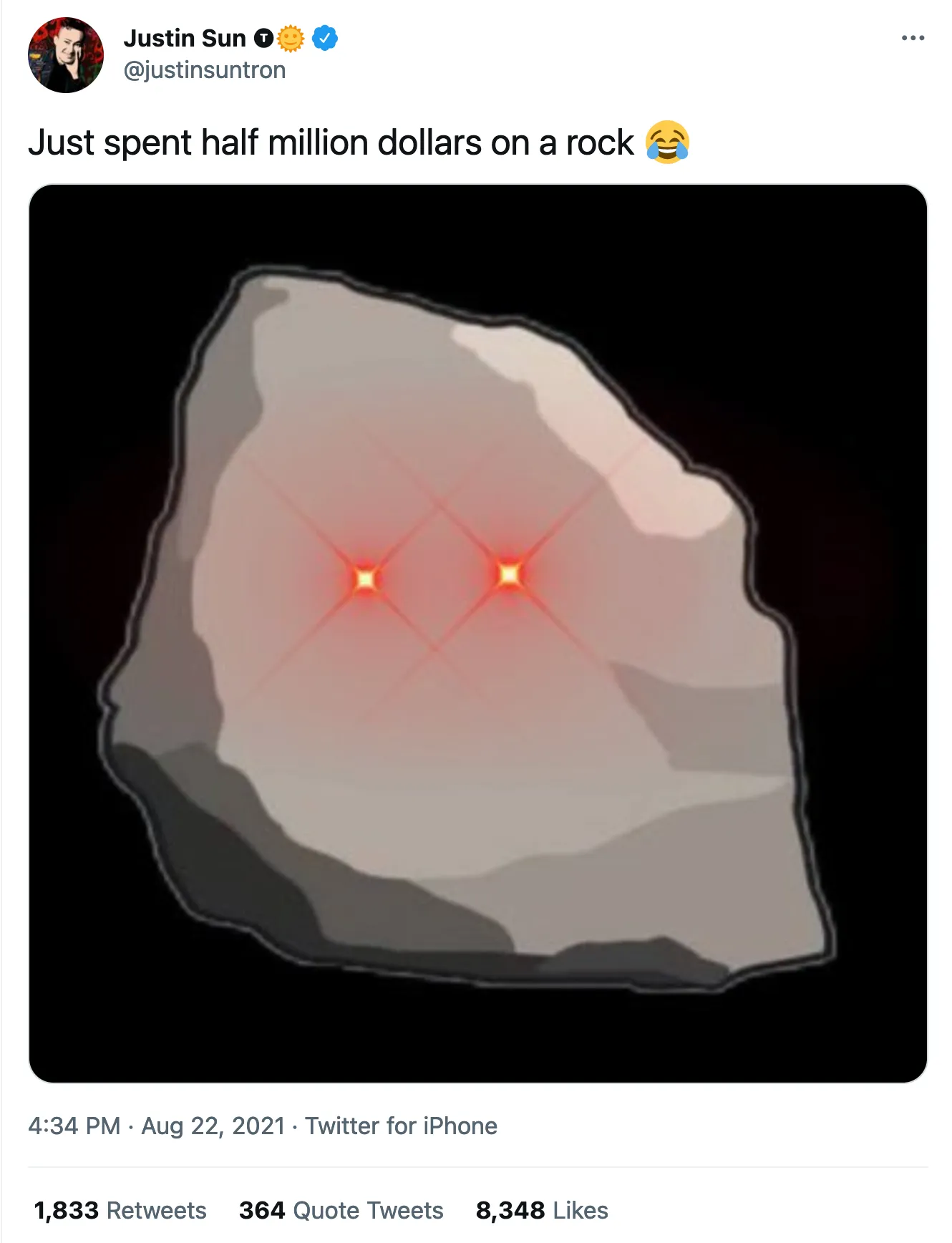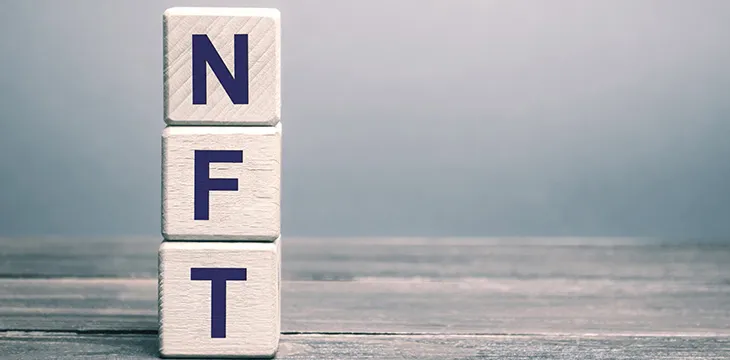|
Getting your Trinity Audio player ready...
|
As a follow up to last week’s article on CDBCs and useful tokens on BSV out of the way, we are finally in a position to address the elephant in the room. Non-fungible tokens (NFTs) which are not issued by high credit quality issuers and their inadvertent use cases. Or more generally, NFTs issued by anyone or everyone on the open market.
As part of a free and open system of public blockchains of course anyone is able to create and issue their own tokens. And the issuer are free to claim whatever the token is good for (most of the time it’s nothing but speculation, i.e. the “greater fool” game). Some of the more exorbitant extreme cases recently are a picture of a rock being sold for US$500,000, by Tron founder Justin Sun, which must raise many eyebrows. What value could they possibly see in a digital drawing of a rock? Especially ones which do not even bestow IP rights to the owners?
A good question! But first, let’s take a step back…
The whole “ape” craze which was started with the Bored Ape series of NFTs, garnering much attention as they involved famous auction house[1] Sotheby’s to run their auction sales, lending credence and credibility which was something that projects in this industry rarely enjoy—it worked, some of the auctioned NFTs sold for up to US$2.9 million! The company Yuga Labs that issued them claims that the NFTs are membership tokens to their special exclusive online ‘Yacht Club’ run on their website. They additionally grant IP rights of the NFT image to the owner, something which is a rare positive compared to the industry. Contemporary art specialist from Sotheby’s Michael Bouhanna assuaged the fears that this isn’t a bubble…And who would want to contradict an art expert?
“People were talking about a bubble in March, in June, etc, and then we see that the market is even stronger today so I think they’ve been proven wrong … I think it’s a very organic market with great collectors who have great appreciation of art,” he said.
At an average secondary market price of US$70,000, personally I don’t think computer generated random ape busts would be worth that much, but what do I know about art? I would be really angry if I were the original artist though.
Other projects which are ‘aping’ (unavoidable pun) Yuga Labs aren’t even putting the extra effort and time to ensure that the NFTs they are selling are usable for anything. The Evolved Apes project, which was originally issued and sold as an NFT with the intention that the money raised would be used to develop a MMO game where the NFT apes would be able to do battle with others in an evolutionary ‘survival of the fittest’ game. That project recently experienced a hard crash when the lead designer absconded with all the money.[2] I guess the Darwin Award goes to all the buyers of that token who were swept up in the NFT craze too much to pay attention to the clear warning signs on this pump and dump/bait and switch scheme. Moral of the story is that a new unregulated market like NFTs are going to have more than your fair share of charlatans and snake oil salesmen. Never put your money into anything that is not backed by a legitimate company operating within a legal jurisdiction in which you have legal recourse. And especially NEVER in one that has anonymous developers and stakeholders.
Let’s leave the legality of the different projects aside for a moment and let’s examine the economic viability of the speculative NFT market in general. By speculative NFTs, I mean any NFT whose value is not legally bound to real world chattel (property or asset). Or ones that are ‘access’ tokens to online services that are experimental or dubious in value such as that of the Bored Apes Yacht club. (As of writing, the only practical use of a bored ape token is access to a special members only area on their website, where members can take turns painting pixels on a shared canvas). Are these assets really worth upwards of an average yearly salary for purportedly ‘rare and collectible’ algorithmically generated pictures of apes, cyberpunks, or rocks? Or perhaps they are capitalizing on the meme and self-identifying counter-culture that is being curated amongst the young and impressionable in our society, all willing to ‘buy-in’ to anti-establishmentalism?
Let’s be frank here. It’s neither. To think otherwise is naive. The kind of naivety that only the younger generations that haven’t lived through the last couple of bubble cycles (Junk Bonds, Dot.com, Subprime) could be guilty of. Does this mean that there isn’t real honest speculator interest? No, there is. But speculators don’t drive fundamental volume. They speculate on the increasing value the movement of trade volume that is already observable. Speculators require volume and liquidity. There needs to be an intrinsic demand for these NFTs before speculators see value in investing in them for value appreciation purposes. So what is that underlying demand for NFTs coming from, if these are virtual assets without any real world tangible value?
Simple.
Money laundering. Nobody wants to hear it, but it needs to be said. Money laundering and proceeds of crime amounted to $1.6 trillion in 2009, or about 2.7% of global GDP according to a UNODC report. That is a lot of money. All that money wants to get back into legitimate markets, besides, what good is participating in crime if you cannot use the proceeds? We can think of proceeds of crime (POC), generated globally, as having an intrinsic demand or drive to gravitate back into the global legit markets, and it will take the path of least resistance to get there. There are plenty of semi-legal and illegal ways in which POC can make its way back into the regular banking system at different cost premiums (through casinos, shadow banks, Hawala systems), but what better way of doing so than through digital collectibles? Friction is minimal, and the fair valuation of a collectible is flexible and bespoke.
Unlike trading in cryptocurrencies directly, the buyer and seller of an NFT can effectively name their price, (usually matching the amount of money that needs to be moved, discounted by a premium), which may be off-market, important because unloading an asset vastly over or under market price is a red flag for accountants and auditors. But for NFTs there seems to be no fair market to mark against. Each token is unique after all (part of the design). So you can claim that you managed to just coincidentally find a rare collector of old-soviet era paraphernalia, and that is why they were willing to pay you $2.9 million for a digital picture of an ape dressed as Che Guevara. At least that is how the story will go, honest, your Honor!
Speculators may actually be avante garde progressive art buffs. Who knows? And when you have speculators, you attract arbitrageurs. Arbitrage profits are great, but every arbitrageur is profiting from transferring value, taking advantage of the discrepancy in value in one market vs another. But in such an unregulated and uncontrolled market of NFTs like OpenSea, arbitrage profit can be interpreted as something else—the premium for laundering money. Compared to the traditional means of shadow banking charging premiums of over 20%, it would seem that NFTs have found their niche market… providing liquidity for funds at a lower friction and cost point than the existing established underground channels. Even if that wasn’t the intent of most of the participants or the creators of these decentralized markets, there is little doubt that it would seem a very attractive use case for POC. Money never sleeps after all, and it spends all its time trying to get where it wants to go.
There will always be arbitrage opportunities so long as there are laws that prevent the movement of proceeds of crime. We just have to be careful to only extract value from legal arbitrage… and not partake in ones of the other kind. When the deal sounds a little too good to be true, then sometimes, that is because it may be tapping into the $1.6+ trillion worth of money that desperately wants to get back into system, and looking for someone to facilitate it.
The market is foaming and growing, and it is filled with many participants: art enthusiasts, speculators, arbitrageurs, bandwagon joiners and fools, all help facilitate it, but it is largely driven by the money launderers. They are the ones holding the $1.6T funneling it through whichever channels it will go. So next time somebody tells you that they just spent half a million dollars on a picture of a rock, or a year’s salary on a computer generated picture of an ape, ask yourself which of these classes of participants they are most likely to be?

***
References:
[1] Sotheby’s Bored Ape’s avg $70k per ape, with the highest one going for $2.9m. – Reuters
[2] Evolved Ape NFT holders go Apeshit – PCGamer

 07-14-2025
07-14-2025 





